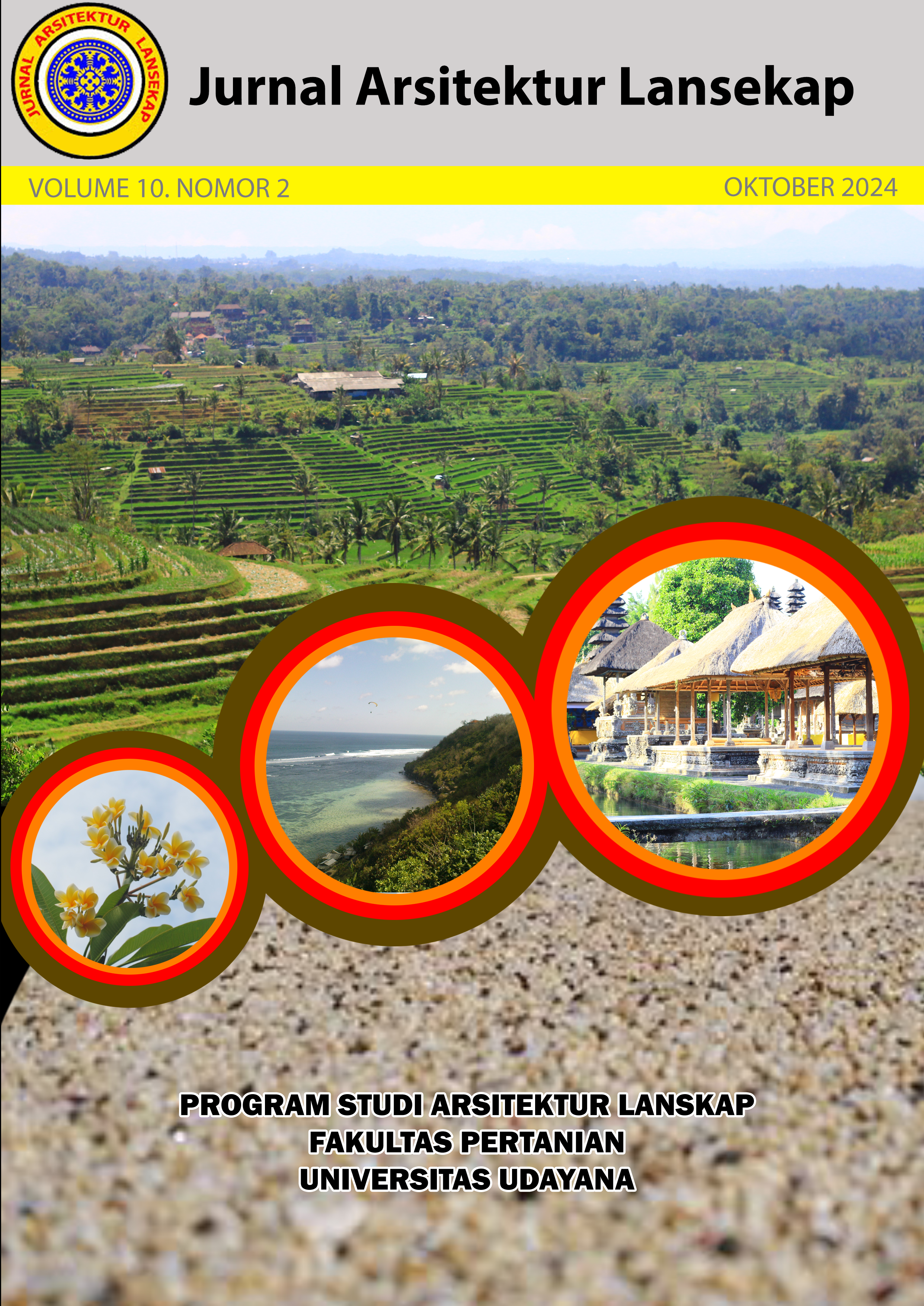Tinjauan Penggunaan Tanaman dalam Perencanaan dan Reka Bentuk Lanskap untuk Mitigasi Longsor
Abstract
Landforms vary from flat to undulating and steep. Steepness in a landscape can enhance aesthetic value but also poses challenges if not managed properly. Landslides are a significant risk associated with steep topography, and to mitigate this impact, landscape architects can incorporate mitigation strategies within landscape planning and design. Mitigation, a biotechnological approach, has proven effective in increasing slope stability. A variety of plant strata—from groundcovers like grasses to herbs, shrubs, and trees—can be integrated into landscape plans to support landslide mitigation. This paper presents a qualitative literature review, employing descriptive-analytical methods to identify optimal criteria for plant-based landslide mitigation in landscape planning and design.
Downloads
References
Bondarenko, I., Kokhan, N., Gonchar, O., & Bondarenko, B. (2019). MANMADE-LANDFORMS-IN-LANDSCAPE-DESIGN-OF-TERRITORIES-AS-A-MEANS-OF-SOLVING-ENVIRONMENTAL-PROBLEMS. Architecture, Civil Engineering, Environement, 7–14. https://doi.org/10.21307/ACEE-2019-047
Chakraborty, A., & Khan, S. (2024). Soil Bioengineering Using Vetiver for Climate-Adaptive Slope Repair: Review. Natural Hazards Review, 25(3). https://doi.org/10.1061/nhrefo.nheng-2014
Chiatante, D., Scippa, S. G., Di Iorio, A., & Sarnataro, M. (2002). The influence of steep slopes on root system development. Journal of Plant Growth Regulation, 21(4), 247–260. https://doi.org/10.1007/s00344-003-0012-0
Dandridge, C., Stanley, T. A., Kirschbaum, D. B., & Lakshmi, V. (2023). Spatial and temporal analysis of global landslide reporting using a decade of the Global Landslide Catalog. Sustainability, 15(3323), 1–22. https://doi.org/https://doi.org/10.3390/su15043323
Erell, E. (2017). Urban Greening and Microclimate Modification. In P. Y. Tan & C. Y. Jim (Eds.), Greening Cities: Forms and Functions (pp. 73–93). Springer Singapore. https://doi.org/10.1007/978-981-10-4113-6_4
Finlayson, C. M., D’Cruz, R., & Davidson, N. (2005). Ecosystems and human well-being : wetlands and water: synthesis. World Resources Institute.
Galindo, V., Calle, Z., Chará, J., & Armbrecht, I. (2017). Facilitation by pioneer shrubs for the ecological restoration of riparian forests in the Central Andes of Colombia. Restoration Ecology, 25(5), 731–737. https://doi.org/10.1111/rec.12490
Gonzalez-Ollauri, A., & Mickovski, S. B. (2016). Using the root spread information of pioneer plants to quantify their mitigation potential against shallow landslides and erosion in temperate humid climates. Ecological Engineering, 95, 302–315. https://doi.org/10.1016/j.ecoleng.2016.06.028
Hu, X. song, Brierley, G., Zhu, H. li, Li, G. rong, Fu, J. tao, Mao, X. qing, Yu, Q. qin, & Qiao, N. (2013). An exploratory analysis of vegetation strategies to reduce shallow landslide activity on loess hillslopes, Northeast Qinghai-Tibet Plateau, China. Journal of Mountain Science, 10(4), 668–686. https://doi.org/10.1007/s11629-013-2584-x
Ismayani, N., & Febrianto, H. (2020). PENCEGAHAN LONGSOR MELALUI KONSERVASI LAHAN DI KECAMATAN SIMPANG EMPAT KABUPATEN KARO. Jurnal Azimut, 9–14. https://ojs.unitas-pdg.ac.id/index.php/azimuthttps://ojs.unitas-pdg.ac.id/index.php/azimut|9
Jandyal, T., & Shah, M. Y. (2024). An experimental investigation on the effect of vetiver grass root system on the engineering properties of soil. Life Cycle Reliability and Safety Engineering. https://doi.org/10.1007/s41872-024-00257-7
Kelbore, Z. A., & Wote, T. T. (2023). Fanyaaju stabilization and productivity of Pennisetum Pedicellatum in response to planting position and spacing at Hawassa Lake watershed, Southern Ethiopia. Cogent Food and Agriculture, 9(2). https://doi.org/10.1080/23311932.2023.2275401
Kirschbaum, D., Stanley, T., & Zhou, Y. (2015). Spatial and temporal analysis of a global landslide catalog. Geomorphology, 249, 4–15. https://doi.org/10.1016/j.geomorph.2015.03.016Li, J., Huang, Z., Zhu, Z., & Ding, G. (2024). Coexistence Perspectives: Exploring the impact of landscape features on aesthetic and recreational values in urban parks. Ecological Indicators, 162. https://doi.org/10.1016/j.ecolind.2024.112043
Mickovski, S. B., & van Beek, L. P. H. (2009). Root morphology and effects on soil reinforcement and slope stability of young vetiver (Vetiveria zizanioides) plants grown in semi-arid climate. Plant and Soil, 324(1), 43–56. https://doi.org/10.1007/s11104-009-0130-y
Navarro-Cano, J. A., Goberna, M., & Verdú, M. (2019). Using plant functional distances to select species for restoration of mining sites. Journal of Applied Ecology, 56(10), 2353–2362. https://doi.org/10.1111/1365-2664.13453
Nono, K. M., Toly, S. R., Bhuja, P., Boro, T. L., Danong, M. T., & Ragha, T. B. (2022). Inventarisasi jenis tumbuhan yang berperan sebagai mitigasi longsor di Taman Wisata Rohani Wolowio Kecamatan Bajawa Kabupaten Ngada. Jurnal Biotropikal Sains, 19(3), 50–58. https://ejurnal.undana.ac.id/index.php/biotropikal/issue/view/515
Petrone, A., & Preti, F. (2010). Soil bioengineering for risk mitigation and environmental restoration in a humid tropical area. Hydrology and Earth System Sciences, 14(2), 239–250. https://doi.org/10.5194/hess-14-239-2010
Robinson, N. (2004). The Planting Design Handbook, Second Edition (Second Edition). Ashgate Publishing Company.
Russ, T. (2009). Site Planning and Design Handbook, (2nd edition). McGraw-Hill Companies, Inc.
Stockdale, E. A., Goulding, K. W. T., George, T. S., & Murphy, D. V. (2013). Soil fertility. In Soil Conditions and Plant Growth (pp. 49–85). Blackwell Publishing Ltd. https://doi.org/10.1002/9781118337295.ch3
Subagyono, K., Marwanto, S., & Kurnia, U. (2003). TEKNIK KONSERVASI TANAH SECARA VEGETATIF. Balai Penelitian Tanah. https://repository.pertanian.go.id/handle/123456789/9629
Tardio, G., Mickovski, S. B., Rauch, H. P., Fernandes, J. P., & Acharya, M. S. (2018). The Use of Bamboo for Erosion Control and Slope Stabilization: Soil Bioengineering Works. In Bamboo - Current and Future Prospects. InTech. https://doi.org/10.5772/intechopen.75626
Walker, T. D. (1991). Planting Design (Second Edition). John Wiley & Sons, Inc.
Zakaria, Z., Muslim, D., Irvan Sophian, R., Kuswaryan, S., & Hidayat Tanuwiria, U. (2013). BIO-ENGINEERING, MELALUI PEMANFAATAN TANAMAN KALIANDRA (CALIANDRA CALOTHYRSUS) DI WILAYAH ZONA RAWAN LONGSOR JAWA BARAT. Bulletin of Scientific Contribution, 11, 168–175. https://doi.org/https://doi.org/10.24198/bsc%20geology.v11i3.8297.g3844
Zayadi, R., Andajani, S., Indrawati, E., Kusumah, I. H., & Alam, N. K. (2022). Landslide disaster mitigation training using the vegetative method in the Kasepuhan Traditional Village, Sukabumi Regency. Community Empowerment, 7(6), 1119–1129. https://doi.org/10.31603/ce.6772
Zayadi, R., Kusuma, Z., Leksono, A. S., & Yanuwiadi, B. (2020). THE INFLUENCE OF VEGETATION ROOTS ON SLOPE STABILITY IN LANDSLIDE SUSCEPTIBLE AREAS. INTERNATIONAL JOURNAL OF CIVIL ENGINEERING AND TECHNOLOGY (IJCIET), 11(4). https://doi.org/10.34218/ijciet.11.4.2020.011

This work is licensed under a Creative Commons Attribution-ShareAlike 4.0 International License.
An author who publishes in the Jurnal Arsitektur Lansekap (JAL) agrees to the following terms:
- Author retains the copyright and grants the journal the right of first publication of the work simultaneously licensed under the Creative Commons Attribution-ShareAlike 4.0 License that allows others to share the work with an acknowledgement of the work's authorship and initial publication in this journal
- Author is able to enter into separate, additional contractual arrangements for the non-exclusive distribution of the journal's published version of the work (e.g., post it to an institutional repository or publish it in a book) with the acknowledgement of its initial publication in this journal.
- Author is permitted and encouraged to post his/her work online (e.g., in institutional repositories or on their website) prior to and during the submission process, as it can lead to productive exchanges, as well as earlier and greater citation of the published work (See The Effect of Open Access).
Read more about the Creative Commons Attribution-ShareAlike 4.0 Licence here: https://creativecommons.org/licenses/by-sa/4.0/.







